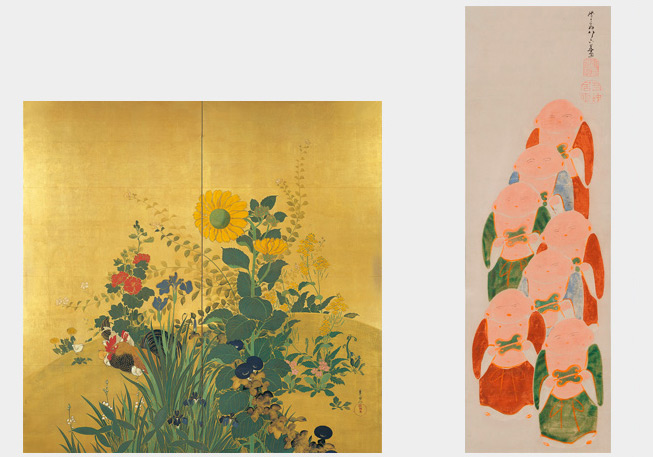Past Exhibition
Special Exhibition Commemorating the 50th Anniversary of the Yamatane Museum of Art
The Best of the Yamatane Collection I
The Glories of Edo Painting:
Matabei, Jakuchū, and the Kanō and Rimpa Schools

Birds and Flowers of the Four Seasons,
Color on Gold-Leafed Paper,
19th Century, Yamatane Museum of Art
Fushimi Dolls,
Color on Paper,
1799, Yamatane Museum of Art
2 July (Sat.) - 21 August (Sun.) 2016
(Closed on 7/19, and on Mondays, except for 7/18)
Hours:10am - 5pm (Last admission at 4:30pm)
Admission Fees: 1,200 [1,000] yen; university and high school students: 900 [800] yen; middle school and younger children: free of charge
*Figures in brackets are for groups of 20 or more, advance tickets, repeaters with used tickets, and those who are wearing kimono.
*Disability ID Holders and one person accompanying them are admitted free of charge.
Organized by: Yamatane Museum of Art and Nikkei Inc.
Highlights of the Exhibition
Chapter 1:
Chapter 2:
Approximately 50 works are to be displayed.
The Yamatane Museum of Art opened on July 7, 1966. In July of 2016, fifty years later, we are launching a series of special exhibitions featuring superb works selected from our collection: The Best of the Yamatane Collection. This exhibition, the first in that series, presents our Edo-period paintings en masse.
Our museum is known for specializing in modern and contemporary nihonga. The collection, however, also contains Edo-period paintings. While small in scale, that part of the collection, which includes two Important Cultural Properties and three Important Art Objects, consists of works of excellent quality that provide an overview of the history of painting in the Edo period from the start of the sixteenth century, when the Tokugawa shogunate was established, to its final years in the latter half of the nineteenth century. Indeed, Edo-period art inspired the collection behind our museum: Yamazaki Taneji, the founder of our museum, first saw a painting by the Edo-period artist Sakai Hōitsu when he was serving his apprenticeship. That stimulated him to collect and, notably, to build a significant collection of Rimpa school works.
The Edo period saw a major expansion of the segment of the population interested in literature and art, to include not only aristocrats and members of the warrior class but also a growing number of the common people. It also saw the emergence of blazing stars, artists with brilliant and highly individual talents, who created new trends. This exhibition introduces superb works representing the important schools that then flourished, from the Rimpa school's Tawaraya Sōtatsu and Hōitsu to Iwasa Matabei, who is regarded as the founding father of ukiyoe, Ike no Taiga, who created literati paintings, Itō Jakuchū, famed for his innovative, eccentric approach, and paintings by members of the Kanō, Maruyama Shijō, and Yamato-e Revivalist schools. In commemoration of our fiftieth anniversary, the exhibition also includes works by modern nihonga artists with whom our museum has had close ties, including Yokoyama Taikan, Kawai Gyokudō, and Uemura Shōen.














